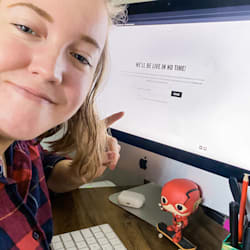Passive aggressive emails aren’t uncommon in a corporate setting, and it’s important that you know how to spot them and reply in a professional manner.
Email communication can sometimes be a minefield of implied meanings and subtle (or not-so-subtle) undertones. It’s not the most clear communication channel, and corporate lingo certainly doesn’t help with clarity.
Recognising and appropriately responding to passive-aggressive emails is crucial for maintaining professional relationships and ensuring clear communication. To land high-paying roles, clarity and professionalism in your response are essential.
Here are eleven common passive-aggressive email phrases you might encounter when you land your first job, and some strategies to respond to them effectively.

11 Passive Aggressive Emails, What They Mean & Responses
“As per my previous email… / Per my last email…”
What it means
This phrase is typically used to indicate that the sender has already addressed the issue or provided the information in an earlier email. It implies that the recipient did not read or remember the information needed.
How you should respond
It’s important that you acknowledge the oversight without seeming defensive. For example:
“Thank you for the reminder. I appreciate your patience. I’ll review the previous email and follow up shortly.”
“Please advise.”
What it means
This phrase is often used when the sender is waiting for instructions or a decision from the recipient. It’s not only limited to passive aggressive emails but can imply impatience or frustration if the response has been delayed or unclear.
How you should respond
Provide a clear and concise response. For example:
“Thank you for your patience. Here are my thoughts on the matter: [Insert response].”
@ultmeche Have you come across any of these emails in your career? How do you respond? Lmk in commente #corporate #email #office #work #engineer ♬ original sound – Engineering Career Coach
“Have you gotten a chance to…?”
What it means
This question usually implies that the sender is waiting for the recipient to complete a task and is subtly reminding them without outright asking.
How you should respond
Acknowledge the task and provide an update on your progress. For example:
“I’ve started working on it and should have an update for you by [specific time]. Thank you for your patience.”
“Should you need further clarification please don’t hesitate to contact me.”
What it means
This phrase suggests that the sender believes their message is clear but anticipates that the recipient might not understand. This isn’t always a passive aggressive tone, sometimes it is used where a recipient may not have specialist knowledge.
How you should respond
Confirm your understanding and thank them for their offer. For example:
“Thank you for the detailed information. I believe I have everything I need, but I’ll reach out if I have any further questions.”
“Thoughts?”
What it means
This brief question is often used to prompt a response or feedback, sometimes suggesting that the sender is eager for a reply. It may be that the sender is looking for validation that they’re on the right track with a project.
This phrase is also used where a sender may be looking for the recipient to take some initiative and lead on the queried topic.
How you should respond
Provide your thoughts or feedback promptly. For example:
“Thank you for sharing this. Here are my initial thoughts: [Insert feedback].”
“Just circling back…”
What it means
This phrase is used to follow up on a previous email or request, implying that the sender has not yet received a response or is waiting for an update.
How you should respond
Acknowledge the follow-up and provide an update. For example:
“Thank you for following up. I’m currently working on this and will get back to you by [specific time].”
“A little confused about…”
What it means
This phrase indicates that the sender did not understand something and expects the recipient to clarify. The bluntness of this phrasing can make corporate emails seem passive aggressive, but it’s important to focus only on the facts in your response.
How you should respond
Provide a clear and detailed explanation. For example:
“I apologize for any confusion. Here’s a more detailed explanation: [Insert explanation].”
“Going forward…”
What it means
This phrase is used to indicate how things should be done in the future, often suggesting a change due to past mistakes or misunderstandings.
How you should respond
Acknowledge the suggestion and show your willingness to adapt. For example:
“Thank you for the feedback. I’ll ensure we follow this approach going forward.”
“Thanks in advance.”
What it means
This phrase assumes that the recipient will comply with a request, implying that the sender expects cooperation. Many passive aggressive emails seem forceful in tone, and it’s often because the sender is very goal-focused or busy so may just be trying to be as efficient as possible by reducing communication.
How you should respond
Acknowledge the request and confirm your intention to comply. For example:
“Thank you for your request. I’ll make sure to get this done by [specific time].”
“Correct me if I’m wrong…”
What it means
This phrase is used to challenge the recipient’s understanding or actions in a way that anticipates there will be an agreement or correction.
How you should respond
Clarify the situation with facts. For example:
“Thank you for bringing this up. Here’s the correct information: [Insert clarification].”

“As per our conversation…”
What it means
This phrase emphasizes that there was a prior verbal discussion, and implies that the recipient should remember and act accordingly.
How you should respond
Confirm your understanding of the conversation and any actions required. For example:
“Thank you for summarizing our conversation. I’ll proceed with [specific action] as discussed.”
Landing Your Dream Role And Making A Good First Impression
When you first start to work in a corporate environment it can be quite an adjustment. There are very specific ways to professionally show frustration or ask direct questions without creating problems.
Hiring managers will want to feel confident that any new hires can act professionally and appropriately where necessary.
First impressions from your resume, cover letter and interview can be key for showcasing your professional skills and ability to handle difficult situations.
About the author

Mollie Buttery
Writer | SEO | Articles & Blog Posts | Social Media
Mollie supports ULTMECHE through website growth, social media, SEO, and also other digital marketing tricks. Mollie has 10+ years experience of in house and freelance marketing experience in industries such as Finance, Law, SAAS, Automotive, Building Services, Commerce, and more. Some of her favorite writing topics consist of sports and finance. Mollie has been key to the growth of ULTMECHE’s SEO and digital marketing efforts.
